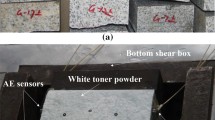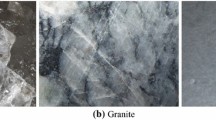Abstract
Surface roughness significantly affects the shear behavior of rock joints; thus, studies on the asperity damage characteristics and its influence on the shear behavior of joints are extremely important. In this paper, shear tests were conducted on tensile granite joints; asperity damage was evaluated based on acoustic emission (AE) events; and the influence of asperity damage on joint shear behavior was analyzed. The results indicated that the total AE events tended to increase with normal stress. In addition, the asperity damage initiation shear stress, which is defined as the transition point from slow growth to rapid growth in the cumulative events curve, was approximately 0.485 of the peak shear strength regardless of the normal stress. Moreover, 63–85% of the AE events were generated after the peak shear stress, indicating that most of the damage occurred in this stage. Both the dilation and the total AE events decreased with shear cycles because of the damage inflicted on asperities during the previous shear cycle. Two stages were observed in the normal displacement curves under low normal stress, whereas three stages (compression, dilation and compression again) were observed at a higher normal stress; the second compression stage may be caused by tensile failure outside the shear plane. The magnitude of the normal stress and the state of asperity are two important factors controlling the post-peak stress drop and stick–slip of granite joints. Serious deterioration of asperities will stop stick–slip from recurring under the same normal stress because the ability to accumulate energy is decreased. The AE b-value increases with the number of shear cycles, indicating that the stress concentration inside the fault plane is reduced because of asperity damage; thus, the potential for dynamic disasters, such as fault-slip rockbursts, will be decreased.
















Similar content being viewed by others
References
Ai C, Zhang J, Li YW et al (2016) Estimation criteria for rock brittleness based on energy analysis during the rupturing process. Rock Mech Rock Eng 49(12):4681–4698. doi:10.1007/s00603-016-1078-x
Asadi MS, Rasouli V, Barla G (2012) A bonded particle model simulation of shear strength and asperity degradation for rough rock fractures. Rock Mech Rock Eng 45:649–675. doi:10.1007/s00603-012-0231-4
Asadi MS, Rasouli V, Barla G (2013) A Laboratory shear cell used for simulation of shear strength and asperity degradation of rough rock fractures. Rock Mech Rock Eng 46:683–699. doi:10.1007/s00603-012-0322-2
Bahaaddini M, Sharrock G, Hebblewhite BK (2013) Numerical direct shear tests to model the shear behaviour of rock joints. Comput Geotech 51:101–115. doi:10.1016/j.compgeo.2013.02.003
Bahaaddini M, Hagan PC, Mitra R, Khosravi MH (2016) Experimental and numerical study of asperity degradation in the direct shear test. Eng Geol 204:41–52. doi:10.1016/j.enggeo.2016.01.018
Brace WF, Byerlee JD (1966) Stick–slip as a mechanism for earthquakes. Science 153:990–992. doi:10.1126/science.153.3739.990
Chan CH, Wu YM, Tseng TL, Lin T, Chen C (2012) Spatial and temporal evolution of b-values before large earthquakes in Taiwan. Tectonophysics 532–535:215–222. doi:10.1016/j.tecto.2012.02.004
Cho N, Martin CD, Sego DC (2008) Development of a shear zone in brittle rock subjected to direct shear. Int J Rock Mech Min Sci 45:1335–1346. doi:10.1016/j.ijrmms.2008.01.019
Colombo IS, Main IG, Forde MC (2003) Assessing damage of reinforced concrete beam using “b-value” analysis of acoustic emission signal. J Mater Civ Eng 15:280–286. doi:10.1061/(ASCE)0899-1561(2003)15:3(280)
Goebel THW, Schorlemmer D, Becker TW, Dresen G, Sammis CG (2013) Acoustic emissions document stress changes over many seismic cycles in stick–slip experiments. Geophys Res Lett 40:2049–2054. doi:10.1002/grl.50507
Grasselli G (2001) Shear strength of rock joints based on quantified surface description. Ph.D. Thesis, Swiss Federal Institute of Technology (EPFL), Lausanne, Switzerland
Grasselli G, Egger P (2003) Constitutive law for the shear strength of rock joints based on three-dimensional surface parameters. Int J Rock Mech Min Sci 40:25–40. doi:10.1016/S1365-1609(02)00101-6
Grasselli G, Wirth J, Egger P (2002) Quantitative three-dimensional description of a rough surface and parameter evolution with shearing. Int J Rock Mech Min Sci 39:789–800. doi:10.1016/S1365-1609(02)00070-9
Gutenberg B, Richter CF (1944) Frequency of earthquakes in California. Bull Seismol Soc Am 34:185–188
Hong E, Kwon T, Song K, Cho G (2016) Observation of the degradation characteristics and scale of unevenness on three-dimensional artificial rock joint surfaces subjected to shear. Rock Mech Rock Eng 49:3–17. doi:10.1007/s00603-015-0725-y
Huang X, Haimson BC, Plesha ME, Qiu X (1993) An investigation of the mechanics of rock joints—part I. Laboratory investigation. Int J Rock Mech Min Sci Geomech Abstr 30:257–269. doi:10.1016/0148-9062(93)92729-A
Hutson RW, Dowding CH (1990) Joint asperity degradation during cyclic shear. Int J Rock Mech Min Sci Geomech Abstr 27:109–119. doi:10.1016/0148-9062(90)94859-R
Indraratna B, Thirukumaran S, Brown ET, Premadasa W, Gale W (2014) A technique for three-dimensional characterisation of asperity deformation on the surface of sheared rock joints. Int J Rock Mech Min Sci 70:483–495. doi:10.1016/j.ijrmms.2014.04.022
Indraratna B, Thirukumaran S, Brown ET, Zhu S (2015) Modelling the shear behaviour of rock joints with asperity damage under constant normal stiffness. Rock Mech Rock Eng 48:179–195. doi:10.1007/s00603-014-0556-2
Jafari MK, Hosseini KA, Pellet F, Boulon M, Buzzi O (2003) Evaluation of shear strength of rock joints subjected to cyclic loading. Soil Dyn Earthq Eng 23:619–630. doi:10.1016/S0267-7261(03)00063-0
Karami A, Stead D (2008) Asperity degradation and damage in the direct shear test: a hybrid FEM/DEM approach. Rock Mech Rock Eng 41:229–266. doi:10.1007/s00603-007-0139-6
Khosravi A (2016) Estimation and validation of post-peak behavior of hard rocks. Ph.D. Dissertation, Ecole Polytechnique Montreal, Montreal
Lee HS, Park YJ, Cho TF, You KH (2001) Influence of asperity degradation on the mechanical behavior of rough rock joints under cyclic shear loading. Int J Rock Mech Min Sci 38:967–980. doi:10.1016/S1365-1609(01)00060-0
Li K, Cao P, Zhang K, Zhong Y (2015) Macro and meso characteristics evolution on shear behavior of rock joints. J Cent South Univ 22:3087–3096. doi:10.1007/s11771-015-2845-7
Meng FZ, Zhou H, Zhang CQ et al (2015) Evaluation methodology of brittleness of rock based on post-peak stress–strain curves. Rock Mech Rock Eng 48(5):1787–1805. doi:10.1007/s00603-014-0694-6
Meng FZ, Zhou H, Wang ZQ, Zhang L, Kong L, Li S, Zhang C (2016) Experimental study on the prediction of rockburst hazards induced by dynamic structural plane shearing in deeply buried hard rock tunnels. Int J Rock Mech Min Sci 86:210–223. doi:10.1016/j.ijrmms.2016.04.013
Moradian ZA, Ballivy G, Rivard P, Gravel C, Rousseau B (2010) Evaluating damage during shear tests of rock joints using acoustic emissions. Int J Rock Mech Min Sci 47:590–598. doi:10.1016/j.ijrmms.2010.01.004
Moradian ZA, Ballivy G, Rivard P (2012) Correlating acoustic emission sources with damaged zones during direct shear test of rock joints. Can Geotech J 49:710–718. doi:10.1139/t2012-029
Nanjo KZ, Hirata N, Obara K, Kasahara K (2012) Decade-scale decrease in b value prior to the M 9-class 2011 Tohoku and 2004 Sumatra quakes. Geophys Res Lett 39:L20304. doi:10.1029/2012GL052997
Nejati HR, Ghazvinian A (2014) Brittleness effect on rock fatigue damage evolution. Rock Mech Rock Eng 47:1839–1848. doi:10.1007/s00603-013-0486-4
Nuannin P, Kulhánek O, Persson L (2012) Variations of b-values preceding large earthquakes in the Andaman–Sumatra subduction zone. J Asian Earth Sci 61:237–242. doi:10.1016/j.jseaes.2012.10.013
Park J, Song J (2009) Numerical simulation of a direct shear test on a rock joint using a bonded-particle model. Int J Rock Mech Min Sci 46:1315–1328. doi:10.1016/j.ijrmms.2009.03.007
Pereira JP, de Freitas MH (1993) Mechanisms of shear failure in artificial fractures of sandstone and their implication for models of hydromechanical coupling. Rock Mech Rock Eng 26:195–214. doi:10.1007/BF01040115
Plesha ME (1987) Constitutive models for rock discontinuities with dilatancy and surface degradation. Int J Numer Anal Methods Geomech 11:345–362. doi:10.1002/nag.1610110404
Qiu X, Plesha ME, Huang X, Haimson BC (1993) An investigation of the mechanics of rock joints. Part II—analytical investigation. Int J Rock Mech Min Sci Geomech Abstr 30:271–287. doi:10.1016/0148-9062(93)92730-E
Rao M, Lakshmi KJP (2005) Analysis of b-value and improved b-value of acoustic emissions accompanying rock. Curr Sci 89:1577–1582
Sainoki A, Mitri HS (2014a) Dynamic modelling of fault slip with Barton’s shear strength model. Int J Rock Mech Min Sci 67:155–163
Sainoki A, Mitri HS (2014b) Simulating intense shock pulses due to asperities during fault-slip. J Appl Geophys 103:71–81. doi:10.1016/j.jappgeo.2014.01.009
Sainoki A, Mitri HS (2015) Evaluation of fault-slip potential due to shearing of fault asperities. Can Geotech J 52:1417–1425
Scholz CH (1968) The frequency–magnitude relation of microfracturing in rock and its relation to earthquakes. Bull Seismol Soc Am 58:399–415
Schorlemmer D, Wiemer S (2005) Earth science: microseismicity data forecast rupture area. Nature 434:1086. doi:10.1038/4341086a
Singh HK, Basu A (2016) Shear behaviors of ‘real’ natural un-matching joints of granite with equivalent joint roughness coefficients. Eng Geol 211:120–134. doi:10.1016/j.enggeo.2016.07.004
Smith WD (1981) The b-value as an earthquake precursor. Nature 289:136–139. doi:10.1038/289136a0
Tang ZC, Wong LNY (2016) New criterion for evaluating the peak shear strength of rock joints under different contact states. Rock Mech Rock Eng 49:1191–1199. doi:10.1007/s00603-015-0811-1
Tarasov BG (2014) Fan-structure shear rupture mechanism as a source of shear rupture rockbursts. J South Afr Inst Min Metall 114:773–784
Tarasov BG, Randolph MF (2011) Super brittleness of rocks and earthquake activity. Int J Rock Mech Min Sci 48(6):888–898. doi:10.1016/j.ijrmms.2011.06.013
Wang W, Scholz CH (1994) Wear processes during frictional sliding of rock: a theoretical and experimental study. J Geophys Res 99:6789–6799. doi:10.1029/93JB02875
Wang J, Chen K, Leu P, Chang C (2016) Precursor times of abnormal b-values prior to mainshocks. J Seismol 20:905–919. doi:10.1007/s10950-016-9567-7
Wawersik WR, Brace WF (1971) Post-failure behavior of a granite and diabase. Rock Mech 3:61–85
Zou DH (1988) Numerical analysis of rock failure and laboratory study of the related acoustic emission. Ph.D. Thesis, University British Columbia, Vancouver
Zou D, Miller HDS, Kaiser PK (1989) Numerical study of violent rock failure by stick-slip on joints. Min Sci Technol 9:241–251. doi:10.1016/S0167-9031(89)90958-4
Acknowledgements
We gratefully acknowledge financial support from the National Program on Key Basic Research Project of China under Grant No. 2014CB046902 and the National Science Foundation of China under Grant Nos. 41172288, 41472270, 41372298 and 51609121. The work in this paper was also supported by the Natural Science Foundation of Shandong Province (Grant No. ZR2016EEQ22), the China Postdoctoral Science Foundation (2016M602109) and the Open Research Fund of State Key Laboratory of Geomechanics and Geotechnical Engineering, Institute of Rock and Soil Mechanics, Chinese Academy of Sciences (Grant No. Z015007).
Author information
Authors and Affiliations
Corresponding authors
Rights and permissions
About this article
Cite this article
Meng, F., Zhou, H., Wang, Z. et al. Characteristics of Asperity Damage and Its Influence on the Shear Behavior of Granite Joints. Rock Mech Rock Eng 51, 429–449 (2018). https://doi.org/10.1007/s00603-017-1315-y
Received:
Accepted:
Published:
Issue Date:
DOI: https://doi.org/10.1007/s00603-017-1315-y




